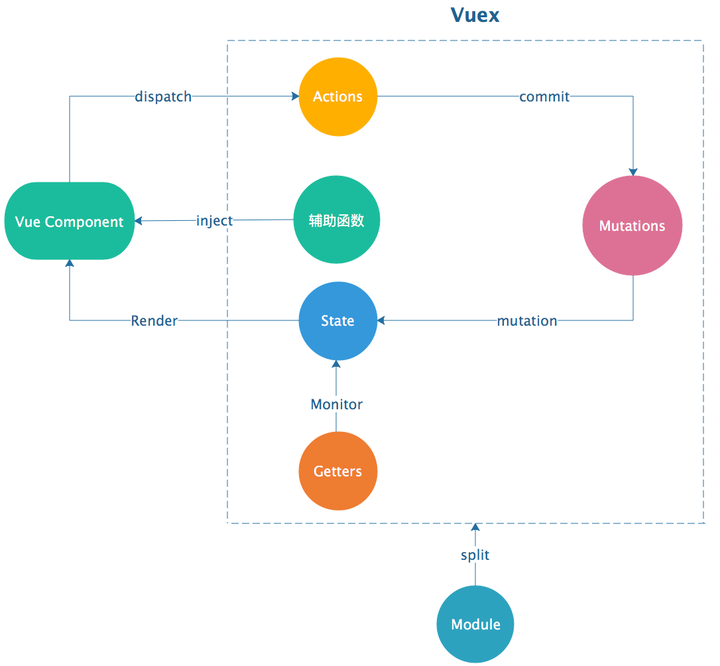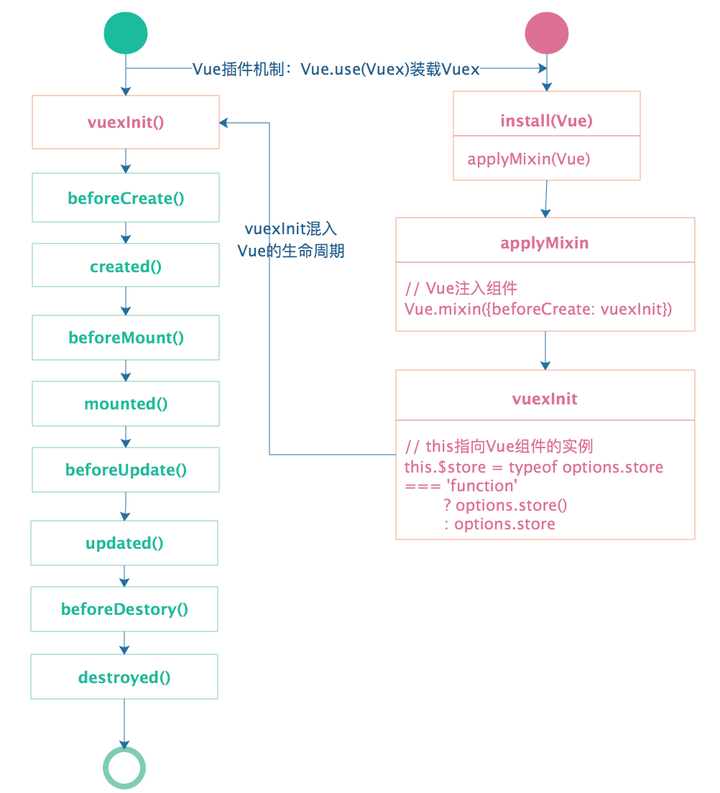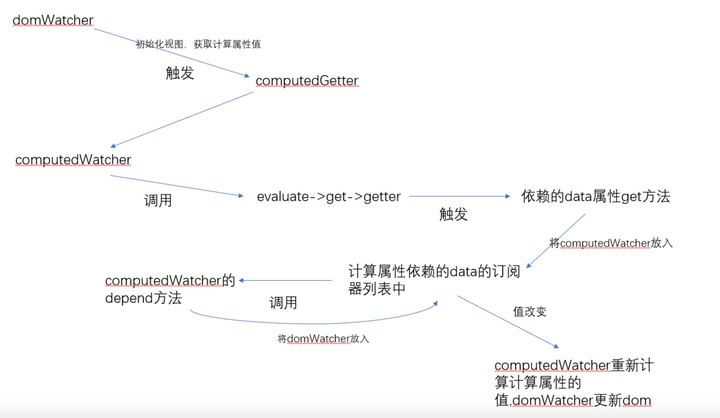vuex最简单、最详细的入门文档以及vuex原理解析
一、Vuex是什么
Vuex是专门为Vuejs应用程序设计的状态管理工具。它采用集中式存储管理应用的所有组件的状态,并以相应的规则保证状态以一种可预测的方式发生变化。
1、Vuex的构成

由上图,我们可以看出Vuex有以下几个部分构成:
1)state
state是存储的单一状态,是存储的基本数据。
2)Getters
getters是store的计算属性,对state的加工,是派生出来的数据。就像computed计算属性一样,getter返回的值会根据它的依赖被缓存起来,且只有当它的依赖值发生改变才会被重新计算。
3)Mutations
mutations提交更改数据,使用store.commit方法更改state存储的状态。(mutations同步函数)
4)Actions
actions像一个装饰器,提交mutation,而不是直接变更状态。(actions可以包含任何异步操作)
5)Module
Module是store分割的模块,每个模块拥有自己的state、getters、mutations、actions。
const moduleA = {
state: { ... },
mutations: { ... },
actions: { ... },
getters: { ... }
}
const moduleB = {
state: { ... },
mutations: { ... },
actions: { ... }
}
const store = new Vuex.Store({
modules: {
a: moduleA,
b: moduleB
}
})
store.state.a // -> moduleA 的状态
store.state.b // -> moduleB 的状态6)辅助函数
Vuex提供了mapState、MapGetters、MapActions、mapMutations等辅助函数给开发在vm中处理store。
2、Vuex的使用

import Vuex from 'vuex';
Vue.use(Vuex); // 1. vue的插件机制,安装vuex
let store = new Vuex.Store({ // 2.实例化store,调用install方法
state,
getters,
modules,
mutations,
actions,
plugins
});
new Vue({ // 3.注入store, 挂载vue实例
store,
render: h=>h(app)
}).$mount('#app');二、Vuex的设计思想
Vuex的设计思想,借鉴了Flux、Redux,将数据存放到全局的store,再将store挂载到每个vue实例组件中,利用Vue.js的细粒度数据响应机制来进行高效的状态更新。
看了Vuex设计思想,心里难免会有这样的疑问:
- vuex的store是如何挂载注入到组件中呢?
- vuex的state和getters是如何映射到各个组件实例中响应式更新状态呢?
三、Vuex的原理解析
我们来看下vuex的源码,分析看看上面2个疑惑的问题:
疑问1:vuex的store是如何挂载注入到组件中呢?
1、在vue项目中先安装vuex,核心代码如下:
import Vuex from 'vuex';
Vue.use(vuex);// vue的插件机制2、利用vue的插件机制,使用Vue.use(vuex)时,会调用vuex的install方法,装载vuex,install方法的代码如下:
export function install (_Vue) {
if (Vue && _Vue === Vue) {
if (process.env.NODE_ENV !== 'production') {
console.error(
'[vuex] already installed. Vue.use(Vuex) should be called only once.'
)
}
return
}
Vue = _Vue
applyMixin(Vue)
}3、applyMixin方法使用vue混入机制,vue的生命周期beforeCreate钩子函数前混入vuexInit方法,核心代码如下:
Vue.mixin({ beforeCreate: vuexInit });
function vuexInit () {
const options = this.$options
// store injection
if (options.store) {
this.$store = typeof options.store === 'function'
? options.store()
: options.store
} else if (options.parent && options.parent.$store) {
this.$store = options.parent.$store
}
}分析源码,我们知道了vuex是利用vue的mixin混入机制,在beforeCreate钩子前混入vuexInit方法,vuexInit方法实现了store注入vue组件实例,并注册了vuex store的引用属性$store。store注入过程如下图所示:

疑问2:vuex的state和getters是如何映射到各个组件实例中响应式更新状态呢?
store实现的源码在src/store.js
1、我们在源码中找到resetStoreVM核心方法:
function resetStoreVM (store, state, hot) {
const oldVm = store._vm
// 设置 getters 属性
store.getters = {}
const wrappedGetters = store._wrappedGetters
const computed = {}
// 遍历 wrappedGetters 属性
forEachValue(wrappedGetters, (fn, key) => {
// 给 computed 对象添加属性
computed[key] = partial(fn, store)
// 重写 get 方法
// store.getters.xx 其实是访问了store._vm[xx],其中添加 computed 属性
Object.defineProperty(store.getters, key, {
get: () => store._vm[key],
enumerable: true // for local getters
})
})
const silent = Vue.config.silent
Vue.config.silent = true
// 创建Vue实例来保存state,同时让state变成响应式
// store._vm._data.$$state = store.state
store._vm = new Vue({
data: {
$$state: state
},
computed
})
Vue.config.silent = silent
// 只能通过commit方式更改状态
if (store.strict) {
enableStrictMode(store)
}
}从上面源码,我们可以看出Vuex的state状态是响应式,是借助vue的data是响应式,将state存入vue实例组件的data中;Vuex的getters则是借助vue的计算属性computed实现数据实时监听。
computed计算属性监听data数据变更主要经历以下几个过程:

小结
Vuex是通过全局注入store对象,来实现组件间的状态共享。在大型复杂的项目中(多级组件嵌套),需要实现一个组件更改某个数据,多个组件自动获取更改后的数据进行业务逻辑处理,这时候使用vuex比较合适。假如只是多个组件间传递数据,使用vuex未免有点大材小用,其实只用使用组件间常用的通信方法即可。
Vue组件简单常用的通信方式有以下几种:
1、父子通信:
父向子传值,通过props;子向父传值通过events ($emit);父调用子方法通过ref;provide / inject。
2、兄弟通信:bus
3、跨级嵌套通信:bus;provide / inject等。
如果你在使用 vue.js , 那么我想你可能会对 vue 组件之间的通信感到崩溃 。
我在使用基于 vue.js 2.0 的UI框架 ElementUI 开发网站的时候 , 就遇到了这种问题 : 一个页面有很多表单 , 我试图将表单写成一个单文件组件 , 但是表单 ( 子组件 ) 里的数据和页面 ( 父组件 ) 按钮交互的时候 , 它们之间的通讯很麻烦 :
<!--父组件中引入子组件-->
<template>
<div>
<a href="javascript:;" @click="show = true">点击</a>
<t-dialog :show.sync="show"></t-dialog>
</div>
</template>
<script>
import dialog from './components/dialog.vue'
export default {
data(){
return {
show:false
}
},
components:{
"t-dialog":dialog
}
}
</script>
<!--子组件-->
<template>
<el-dialog :visible.sync="currentShow"></el-dialog>
</template>
<script>
export default {
props:['show'],
computed:{
currentShow:{
get(){
return this.show
},
set(val){
this.$emit("update:show",val)
}
}
}
}
</script>
之所以这么麻烦 , 是因为父组件可以通过 props 给子组件传递参数 , 但子组件内却不能直接修改父组件传过来的参数。
这时候 , 使用 vuex 就可以比较方便的解决这种问题了 :
<!--父组件中引入子组件-->
<template>
<div>
<a href="javascript:;" @click="$store.state.show = true">点击</a>
<t-dialog></t-dialog>
</div>
</template>
<script>
import dialog from './components/dialog.vue'
export default {
components:{
"t-dialog":dialog
}
}
</script>
<!--子组件-->
<template>
<el-dialog :visible.sync="$store.state.show"></el-dialog>
</template>
<script>
export default {}
</script>
是不是方便了许多 , 这就是 vuex 最简单的应用 , 不要被网上其他教程吓到 , vuex 原来可以这么简单 !
安装、使用 vuex
首先我们在 vue.js 2.0 开发环境中安装 vuex :
npm install vuex --save
然后 , 在 main.js 中加入 :
import vuex from 'vuex'
Vue.use(vuex);
var store = new vuex.Store({//store对象
state:{
show:false
}
})
再然后 , 在实例化 Vue对象时加入 store 对象 :
new Vue({
el: '#app',
router,
store,//使用store
template: '<App/>',
components: { App }
})
完成到这一步 , 上述例子中的 $store.state.show 就可以使用了。
modules
前面为了方便 , 我们把 store 对象写在了 main.js 里面 , 但实际上为了便于日后的维护 , 我们分开写更好 , 我们在 src 目录下 , 新建一个 store 文件夹 , 然后在里面新建一个 index.js :
import Vue from 'vue'
import vuex from 'vuex'
Vue.use(vuex);
export default new vuex.Store({
state:{
show:false
}
})
那么相应的 , 在 main.js 里的代码应该改成 :
//vuex
import store from './store'
new Vue({
el: '#app',
router,
store,//使用store
template: '<App/>',
components: { App }
})这样就把 store 分离出去了 , 那么还有一个问题是 : 这里 $store.state.show 无论哪个组件都可以使用 , 那组件多了之后 , 状态也多了 , 这么多状态都堆在 store 文件夹下的 index.js 不好维护怎么办 ?
我们可以使用 vuex 的 modules , 把 store 文件夹下的 index.js 改成 :
import Vue from 'vue'
import vuex from 'vuex'
Vue.use(vuex);
import dialog_store from '../components/dialog_store.js';//引入某个store对象
export default new vuex.Store({
modules: {
dialog: dialog_store
}
})
这里我们引用了一个 dialog_store.js , 在这个 js 文件里我们就可以单独写 dialog 组件的状态了 :
export default {
state:{
show:false
}
}做出这样的修改之后 , 我们将之前我们使用的 $store.state.show 统统改为 $store.state.dialog.show 即可。
如果还有其他的组件需要使用 vuex , 就新建一个对应的状态文件 , 然后将他们加入 store 文件夹下的 index.js 文件中的 modules 中。
modules: {
dialog: dialog_store,
other: other,//其他组件
}
mutations
前面我们提到的对话框例子 , 我们对vuex 的依赖仅仅只有一个 $store.state.dialog.show 一个状态 , 但是如果我们要进行一个操作 , 需要依赖很多很多个状态 , 那管理起来又麻烦了 !
mutations 登场 , 问题迎刃而解 :
export default {
state:{//state
show:false
},
mutations:{
switch_dialog(state){//这里的state对应着上面这个state
state.show = state.show?false:true;
//你还可以在这里执行其他的操作改变state
}
}
}使用 mutations 后 , 原先我们的父组件可以改为 :
<template>
<div id="app">
<a href="javascript:;" @click="$store.commit('switch_dialog')">点击</a>
<t-dialog></t-dialog>
</div>
</template>
<script>
import dialog from './components/dialog.vue'
export default {
components:{
"t-dialog":dialog
}
}
</script>使用 $store.commit('switch_dialog') 来触发 mutations 中的 switch_dialog 方法。
这里需要注意的是:
mutations中的方法是不分组件的 , 假如你在 dialog_stroe.js 文件中的定义了switch_dialog方法 , 在其他文件中的一个switch_dialog方法 , 那么$store.commit('switch_dialog')会执行所有的switch_dialog方法。mutations里的操作必须是同步的。
你一定好奇 , 如果在 mutations 里执行异步操作会发生什么事情 , 实际上并不会发生什么奇怪的事情 , 只是官方推荐 , 不要在 mutationss 里执行异步操作而已。
actions
多个 state 的操作 , 使用 mutations 会来触发会比较好维护 , 那么需要执行多个 mutations 就需要用 action 了:
export default {
state:{//state
show:false
},
mutations:{
switch_dialog(state){//这里的state对应着上面这个state
state.show = state.show?false:true;
//你还可以在这里执行其他的操作改变state
}
},
actions:{
switch_dialog(context){//这里的context和我们使用的$store拥有相同的对象和方法
context.commit('switch_dialog');
//你还可以在这里触发其他的mutations方法
},
}
}那么 , 在之前的父组件中 , 我们需要做修改 , 来触发 action 里的 switch_dialog 方法:
<template>
<div id="app">
<a href="javascript:;" @click="$store.dispatch('switch_dialog')">点击</a>
<t-dialog></t-dialog>
</div>
</template>
<script>
import dialog from './components/dialog.vue'
export default {
components:{
"t-dialog":dialog
}
}
</script>使用 $store.dispatch('switch_dialog') 来触发 action 中的 switch_dialog 方法。
官方推荐 , 将异步操作放在 action 中。
getters
getters 和 vue 中的 computed 类似 , 都是用来计算 state 然后生成新的数据 ( 状态 ) 的。
还是前面的例子 , 假如我们需要一个与状态 show 刚好相反的状态 , 使用 vue 中的 computed 可以这样算出来 :
computed(){
not_show(){
return !this.$store.state.dialog.show;
}
}
那么 , 如果很多很多个组件中都需要用到这个与 show 刚好相反的状态 , 那么我们需要写很多很多个 not_show , 使用 getters 就可以解决这种问题 :
export default {
state:{//state
show:false
},
getters:{
not_show(state){//这里的state对应着上面这个state
return !state.show;
}
},
mutations:{
switch_dialog(state){//这里的state对应着上面这个state
state.show = state.show?false:true;
//你还可以在这里执行其他的操作改变state
}
},
actions:{
switch_dialog(context){//这里的context和我们使用的$store拥有相同的对象和方法
context.commit('switch_dialog');
//你还可以在这里触发其他的mutations方法
},
}
}我们在组件中使用 $store.state.dialog.show 来获得状态 show , 类似的 , 我们可以使用 $store.getters.not_show来获得状态 not_show 。
注意 : $store.getters.not_show 的值是不能直接修改的 , 需要对应的 state 发生变化才能修改。
mapState、mapGetters、mapActions
很多时候 , $store.state.dialog.show 、$store.dispatch('switch_dialog') 这种写法又长又臭 , 很不方便 , 我们没使用 vuex 的时候 , 获取一个状态只需要 this.show , 执行一个方法只需要 this.switch_dialog 就行了 , 使用 vuex 使写法变复杂了 ?
使用 mapState、mapGetters、mapActions 就不会这么复杂了。
以 mapState 为例 :
<template>
<el-dialog :visible.sync="show"></el-dialog>
</template>
<script>
import {mapState} from 'vuex';
export default {
computed:{
//这里的三点叫做 : 扩展运算符
...mapState({
show:state=>state.dialog.show
}),
}
}
</script>
相当于 :
<template>
<el-dialog :visible.sync="show"></el-dialog>
</template>
<script>
import {mapState} from 'vuex';
export default {
computed:{
show(){
return this.$store.state.dialog.show;
}
}
}
</script>mapGetters、mapActions 和 mapState 类似 , mapGetters 一般也写在 computed 中 , mapActions 一般写在 methods 中。




